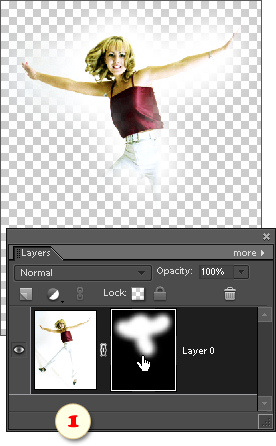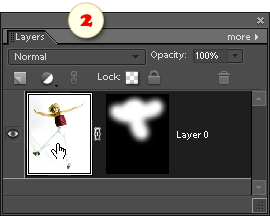Adding a (pixel) layer mask (PSE 6-8)
There are two essential masking techniques.
Here is the "Reveal All" approach:
- Make sure the proper layer is selected in the Layers palette. (Actually, you can mask any layer other than "Background", or even a layer group.)
- Open the "Maks" dialog.
- Apply the "Reveal All"
 command. The mask thumbnail appears in the Layers palette. Its white color means that the entire layer is revealed (not hidden).
command. The mask thumbnail appears in the Layers palette. Its white color means that the entire layer is revealed (not hidden). - Now to hide some area of the layer, you paint over it (or fill it) with black color.
NB Pay your attention to layer and mask thumbnails in the Layers palette. If the layer thumbnail is "framed", it means that the layer (and not the mask) is active. To edit the mask, you have to activate it by clicking its thumbnail (fig. 1). And vise versa, to edit the image itself, you click the layer thumbnail (fig. 2).
Alternatively, you may use the "Hide All" approach:
- Open the "Masks" dialog and apply the "Hide All"
 command. The thumbnail in the Layers palette becomes black and the mask hides the whole layer.
command. The thumbnail in the Layers palette becomes black and the mask hides the whole layer. - Now paint white color to reveal (unmask) a portion of the layer (fig. 1).
Sometimes, though, it is more convenient to create a mask from an active selection. That is, you make a selection, for example with the Polygonal Lasso tool, and then use either the "Reveal Selection"  or "Hide Selection"
or "Hide Selection"  command.
command.
If you decide to swap the masked and revealed areas, apply the "Invert Layer Mask"  command.
command.

